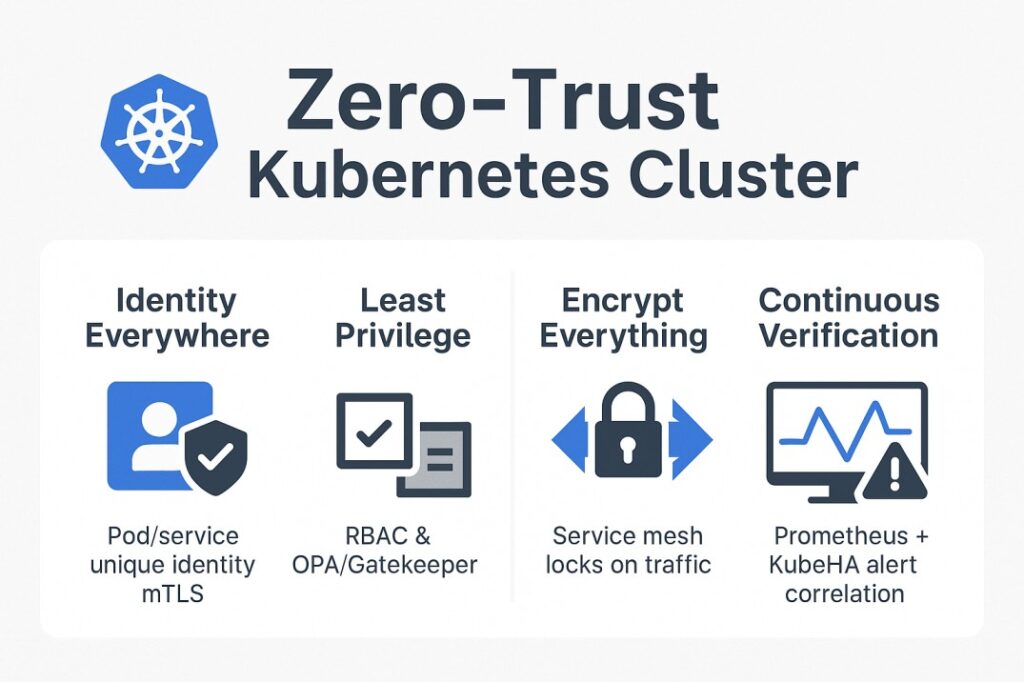

The traditional model of perimeter-based security breaks down in containerized environments. Once a pod or service is compromised, attackers can move laterally across the cluster, access sensitive secrets, or abuse misconfigured RBAC.
The solution is Zero Trust for Kubernetes: enforce identity, least privilege, encryption, and constant verification at every layer.
1. Identity Everywhere: Strong Authentication for Pods & Services
Every workload in Kubernetes must have a unique, verifiable identity.
- Use Service Accounts with tight scoping — never default accounts.
- Enforce mTLS (Mutual TLS) for pod-to-pod communication via Istio or Linkerd:
apiVersion: security.istio.io/v1beta1
kind: PeerAuthentication
metadata:
name: default
namespace: payments
spec:
mtls:
mode: STRICT
Ensures all east–west traffic is authenticated and encrypted.
- Integrate with external identity providers (OIDC, SPIFFE/SPIRE) for workload identities.
SRE Benefit: Stops lateral movement by enforcing cryptographic proof of identity.
2. Least Privilege: Fine-Grained RBAC & Policy Enforcement
A Zero-Trust cluster assumes no pod should have broad access.
- Apply RBAC to scope access tightly per namespace:
apiVersion: rbac.authorization.k8s.io/v1
kind: Role
metadata:
namespace: payments
name: payments-pod-reader
rules:
– apiGroups: [“”]
resources: [“pods”]
verbs: [“get”, “list”]
- Block privilege escalation with OPA Gatekeeper or Kyverno:
apiVersion: constraints.gatekeeper.sh/v1beta1
kind: K8sPSPNoPrivilegedContainer
metadata:
name: disallow-privileged
spec:
enforcementAction: deny
- Disable defaults: no cluster-admin bindings, no pods running as root, no wildcards (*) in RBAC rules.
SRE Benefit: Limits blast radius — even if one pod is compromised, its permissions end at the namespace boundary.
3. Encrypt Everything: From API Server to Pod Traffic
- API Server ↔ etcd: Always enable TLS encryption (–etcd-certfile, –etcd-keyfile).
- Ingress Traffic: Enforce HTTPS everywhere with cert-manager or external-dns + Let’s Encrypt.
- Service Mesh Encryption: Sidecars automatically encrypt east–west traffic. For example, Istio adds mTLS without app code changes.
SRE Benefit: Sensitive data (tokens, credentials, personal data) is never exposed in plaintext — reducing regulatory and breach risks.
4. Continuous Verification: Observability + Automated Defense
Security isn’t static. In Zero-Trust Kubernetes, verification is constant.
- Prometheus: Track failed RBAC attempts, privilege escalation errors, and pod restarts.
- Loki/Fluentd: Centralize logs to detect anomalies.
- Tempo/OpenTelemetry: Trace API calls across services to spot abuse.
- KubeHA Integration:
- Correlates suspicious events (e.g., API misuse + failed pod auth).
- Surfaces the root cause instead of flooding engineers with alerts.
- Suggests remediation (kubectl delete pod, tighten RBAC, enforce OPA policy).
SRE Benefit: From alert storm → root cause → remediation in minutes, not hours.
5. Real-World Attack Path Prevented by Zero Trust
Without Zero Trust:
- Attacker compromises frontend-service.
- Pod token allows listing secrets cluster-wide.
- Attacker pivots into payments namespace → extracts DB credentials.
With Zero Trust:
- Pod token scoped only to frontend namespace.
- Policy blocks privileged container launch.
- Service mesh enforces mTLS → no lateral pod-to-pod movement.
- KubeHA flags suspicious RBAC violations in real time.



Experience KubeHA today: www.KubeHA.com
KubeHA’s introduction, 